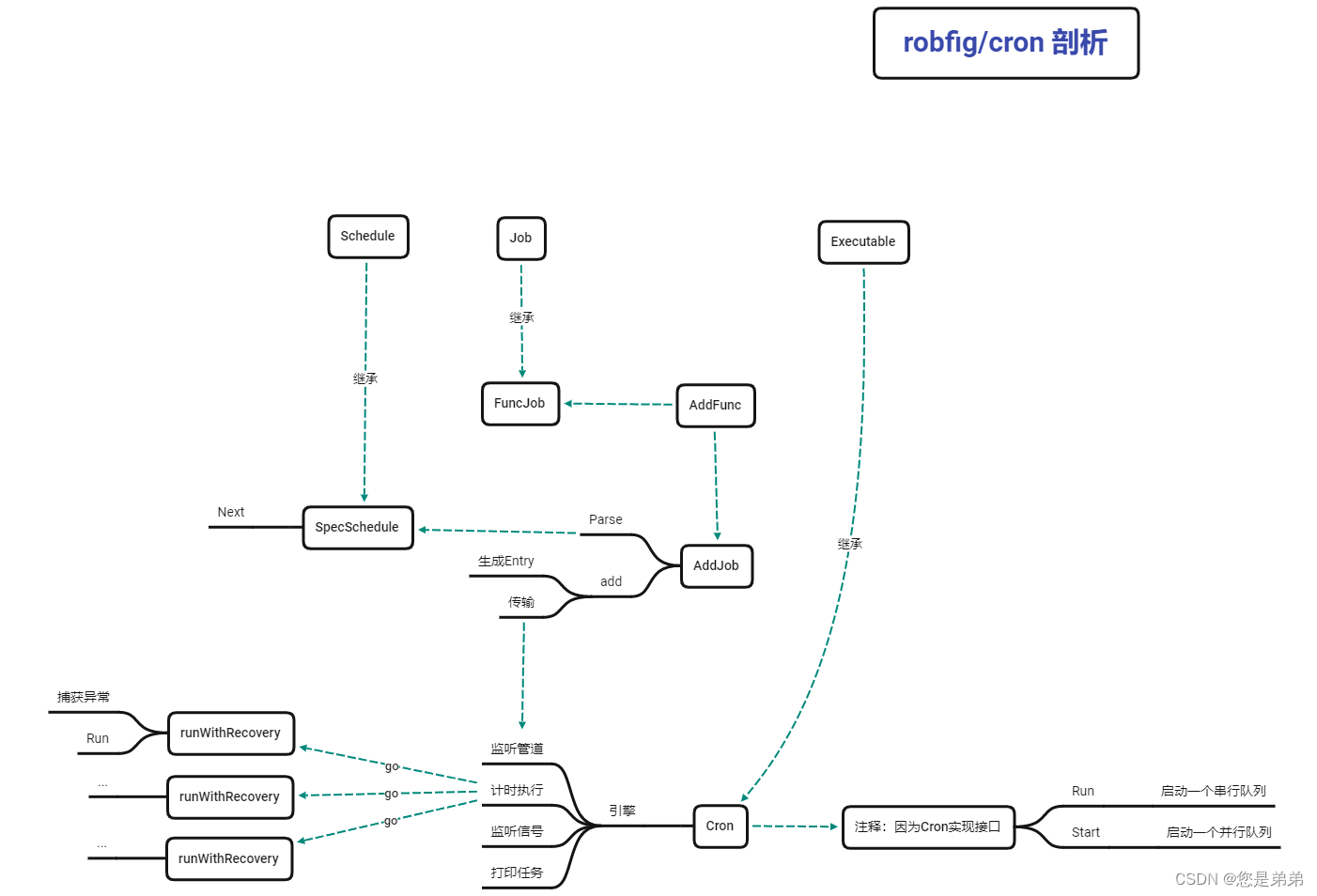-
robfig/cron-go cron定时任务库架构剖析
Cron深度解析
思想
对于cron 这个三方库来说,他可以说是做两件事,其一是:解析cron string,生成一个定时器,达到循环时间发送信号。其二是核心(引擎):用以执行,判断,接收任务,停止cron等事情。
robfig/cron at v3.0.1架构图

关键位置分析
Cron 实现 Executable 接口
Executable 接口 有三个方法,Cron结构体继承。
- 通过Start 会 启动一个并行队列
- 通过Run 会启动一个串行队列
// Start the cron scheduler in its own go-routine, or no-op if already started. func (c *Cron) Start() { if c.running { return } c.running = true go c.run() } // Run the cron scheduler, or no-op if already running. func (c *Cron) Run() { if c.running { return } c.running = true c.run() }- 1
- 2
- 3
- 4
- 5
- 6
- 7
- 8
- 9
- 10
- 11
- 12
- 13
- 14
- 15
- 16
- 17
Cron 结构体分析
// Cron keeps track of any number of entries, invoking the associated func as // specified by the schedule. It may be started, stopped, and the entries may // be inspected while running. type Cron struct { entries []*Entry stop chan struct{} add chan *Entry snapshot chan []*Entry running bool ErrorLog *log.Logger location *time.Location }- 1
- 2
- 3
- 4
- 5
- 6
- 7
- 8
- 9
- 10
- 11
- 12
- entries:指针切片,用以执行当中的entry(即每一个任务)以及接收传进来的任务
- stop:停止信号
- add:接收传输管道
- snapshot:entries 副本,打印需要
cron string 解析
在 AddJob 方法中,通过Parse 函数获取实现了Schedule 接口的结构体:SpecSchedule
func parseDescriptor(descriptor string) (Schedule, error) { switch descriptor { case "@yearly", "@annually": return &SpecSchedule{ Second: 1 << seconds.min, Minute: 1 << minutes.min, Hour: 1 << hours.min, Dom: 1 << dom.min, Month: 1 << months.min, Dow: all(dow), }, nil case "@monthly": return &SpecSchedule{ Second: 1 << seconds.min, Minute: 1 << minutes.min, Hour: 1 << hours.min, Dom: 1 << dom.min, Month: all(months), Dow: all(dow), }, nil ...... } // 该结构体实现了 Schedule 接口 type SpecSchedule struct { Second, Minute, Hour, Dom, Month, Dow uint64 }- 1
- 2
- 3
- 4
- 5
- 6
- 7
- 8
- 9
- 10
- 11
- 12
- 13
- 14
- 15
- 16
- 17
- 18
- 19
- 20
- 21
- 22
- 23
- 24
- 25
- 26
- 27
- 28
引擎解析
// Run the scheduler. this is private just due to the need to synchronize // access to the 'running' state variable. func (c *Cron) run() { // Figure out the next activation times for each entry. now := c.now() for _, entry := range c.entries { entry.Next = entry.Schedule.Next(now) } for { // Determine the next entry to run. sort.Sort(byTime(c.entries)) var timer *time.Timer if len(c.entries) == 0 || c.entries[0].Next.IsZero() { // If there are no entries yet, just sleep - it still handles new entries // and stop requests. timer = time.NewTimer(100000 * time.Hour) } else { timer = time.NewTimer(c.entries[0].Next.Sub(now)) } for { select { case now = <-timer.C: now = now.In(c.location) // Run every entry whose next time was less than now for _, e := range c.entries { if e.Next.After(now) || e.Next.IsZero() { break } go c.runWithRecovery(e.Job) e.Prev = e.Next e.Next = e.Schedule.Next(now) } case newEntry := <-c.add: timer.Stop() now = c.now() newEntry.Next = newEntry.Schedule.Next(now) c.entries = append(c.entries, newEntry) case <-c.snapshot: c.snapshot <- c.entrySnapshot() continue case <-c.stop: timer.Stop() return } break } } }- 1
- 2
- 3
- 4
- 5
- 6
- 7
- 8
- 9
- 10
- 11
- 12
- 13
- 14
- 15
- 16
- 17
- 18
- 19
- 20
- 21
- 22
- 23
- 24
- 25
- 26
- 27
- 28
- 29
- 30
- 31
- 32
- 33
- 34
- 35
- 36
- 37
- 38
- 39
- 40
- 41
- 42
- 43
- 44
- 45
- 46
- 47
- 48
- 49
- 50
- 51
- 52
- 53
- 54
- 55
就是一个循环,循环等,循环加。
改进点
可以发现在这其中并没有写注销某一个定时任务的方法
但是想实现也是比较简单的,加一个case,监听channel,遍历 entries,找到目标,删除掉就ok了
但是既然它不加,应该是有原因的,不加的原因应该是处于经验考虑的吧?
-
相关阅读:
[附源码]计算机毕业设计JAVA公益劳动招募管理系统
ResNet网络详解及其PyTorch实现
C#中反射的使用总结
安卓手机APP开发__媒体开发部分__播放器的接口
Django-(8)
Hive集群高可用配置与impala集群高可用配置
这是什么代码帮我看看
北大肖臻老师《区块链技术与应用》系列课程学习笔记[15]以太坊-交易树和收据树
MARS: An Instance-aware, Modular and Realistic Simulator for Autonomous Driving
Multitask Vision-Language Prompt Tuning
- 原文地址:https://blog.csdn.net/wys74230859/article/details/128135071
